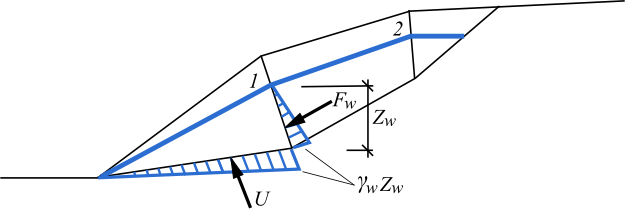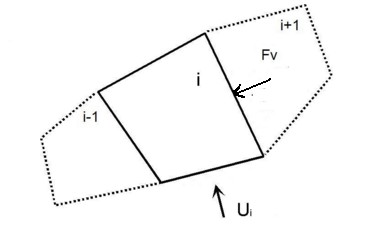Influence of Water
The influence of water can be considered using the following options: general shape of GWT, horizontal GWT, or directly by water acting on the blocks.
General shape of GWT
The general shape of GWT is entered as a polygon. The pore pressure (stress) on the slip surface is considered linearly according to the equation: u = γw * zw.
where: | γw | - | unit weight of water |
zw | - | height of GWT above slip surface in the joints |
The resultant forces U (force due to water on slip surface) or Fw (force due to water on internal slip surface acting on the submerged part of joint per metre of width) are calculated from the pore pressure load diagrams.
 Forces from the water acting on the block - water can flow freely of the gap
Forces from the water acting on the block - water can flow freely of the gap
 Forces from the water acting on the block - water can't flow of the gap
Forces from the water acting on the block - water can't flow of the gap
Horizontal GWT
The horizontal GWT is entered by constant height hw over the heel of the slope (from the origin of the coordinate system). The influence of water is considered from the water level (GWT) to a given point on the vertical.
Water entered on blocks
The water pressure along the joints and on the slip surface can be taken into account. It is introduced as an external load:
Force due to water on internal slip surface (water between blocks) Fv
It must be introduced into the analysis whenever the presence of water in the joints between blocks is expected. It is applied as a resultant force Fv in kN (the pressure acting on the immerse part of the joint per 1m run is considered).
Force due to water on external slip surface (uplift pressure) U
It is defined as hydrostatic pressure on each slip surface of the polygon (external slip surface) separately and introduced as an external load (uplift pressure) U in kN, which can be reduced depending on the slip surface permeability (the pressure acting on the immerse part of the slip surface per 1m run is considered).
 Water forces acting on a rock block
Water forces acting on a rock block